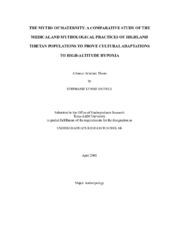| dc.creator | Shively, Stephanie Lynne | |
| dc.date.accessioned | 2009-09-30T20:15:36Z | |
| dc.date.available | 2009-09-30T20:15:36Z | |
| dc.date.issued | 2009-09-30 | |
| dc.identifier.uri | https://hdl.handle.net/1969.1/88034 | |
| dc.description.abstract | This paper presents the physiological adaptations to high altitude present in Tibetan and Nepalese populations, and reviews of the cultural practices surrounding childbirth which appear to have a connection to the stresses of hypoxic conditions. It concludes that the religious, secular, and folklore-related birthing rituals present in Tibetan and Nepalese society can be seen as cultural adaptations to high altitude stress. The paper also expands the work of past studies, combining physiological and cultural research in order to argue the existence of a cooperation between environmental and cultural stresses. It goes on to show that the cultural rituals surrounding childbirth in Tibet and Nepal act to enhance the environmental stresses in order to weed out the less well adapted infants, speed up the return of the mother to reproduction, and mollify the dangerous aspects of the environment for those that survive. By doing so, the cultural rituals work with the environment in order to increase the occurrence of adaptations to high altitude stress. | en |
| dc.language.iso | en_US | |
| dc.subject | Tibet, Nepal, Himalayas, high altitude, hypoxia, childbirth, ritual, cultural adaptation | en |
| dc.title | The Myths of Maternity: A Comparative Study of the Medical and Mythological Practices of Highland Tibetan Populations to Prove Cultural Adaptations to High-Altitude Hypoxia | en |
| dc.type | Thesis | en |


